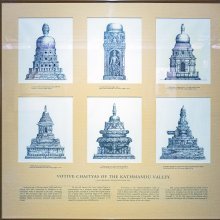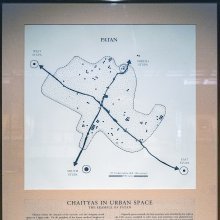Baha, Bāhā, Bāha: 13 definitions
Introduction:
Baha means something in Hinduism, Sanskrit, Buddhism, Pali, Jainism, Prakrit. If you want to know the exact meaning, history, etymology or English translation of this term then check out the descriptions on this page. Add your comment or reference to a book if you want to contribute to this summary article.
Images (photo gallery)
In Hinduism
Ayurveda (science of life)
Veterinary Medicine (The study and treatment of Animals)
Source: Shodhganga: Portrayal of Animal Kingdom (Tiryaks) in Epics An Analytical studyBāha (बाह) is a synonym (another name) for the Horse (Aśva), according to scientific texts such as the Mṛgapakṣiśāstra (Mriga-pakshi-shastra) or “the ancient Indian science of animals and birds” by Hamsadeva, containing the varieties and descriptions of the animals and birds seen in the Sanskrit Epics such as the Ramayana and Mahabharata.

Āyurveda (आयुर्वेद, ayurveda) is a branch of Indian science dealing with medicine, herbalism, taxology, anatomy, surgery, alchemy and related topics. Traditional practice of Āyurveda in ancient India dates back to at least the first millenium BC. Literature is commonly written in Sanskrit using various poetic metres.
Languages of India and abroad
Pali-English dictionary
Source: BuddhaSasana: Concise Pali-English Dictionarybāhā : (f.) the arm; a post; a handle.
Source: Sutta: The Pali Text Society's Pali-English DictionaryBāhā, (f.) (a specific Pali doublet of bāhu, q. v. It is on the whole restricted to certain phrases, but occurs side by side of bāhu in others, like pacchā-bāhaṃ & °bāhuṃ, bāhaṃ & bāhuṃ pasāreti) 1. the arm A. II, 67=III, 45 (°bala); Vin. II, 105; J. III, 62; V, 215 (°mudu). pacchā-bāhaṃ arm(s) behind (his back) D. I, 245 (gāḷhabandhanaṃ baddha). bāhaṃ pasāreti to stretch out the arm D. I, 222=M. I, 252≈. bāhāyaṃ gahetvā taking (him or her) by the arm D. I, 221 sq. ; M. I, 365 (nānā-bāhāsu g.); PvA. 148. bāhā paggayha reaching or stretching out one’s arms (as sign of supplication) D. II, 139; J. V, 267; PvA. 92 and passim.—2. not quite certain, whether “post” of a door or a “screen” (from bahati3), the former more likely. Only —° in ālambana° post to hold on to, a balustrade Vin. II, 120, 152; dvāra° doorpost D. II, 190; Pv. I, 51. Cp. bāhitikā.—aṭṭhi (bāh°) arm-bone KhA 50.—paramparāya arm in arm Vin. III, 126. (Page 486)

Pali is the language of the Tipiṭaka, which is the sacred canon of Theravāda Buddhism and contains much of the Buddha’s speech. Closeley related to Sanskrit, both languages are used interchangeably between religions.
Sanskrit dictionary
Source: DDSA: The practical Sanskrit-English dictionaryBāha (बाह).—
1) The arm.
2) A horse.
Derivable forms: bāhaḥ (बाहः).
--- OR ---
Bāhā (बाहा).—The arm; मां प्रत्यालिङ्गेतोगताभिः शाखाबाहाभिः (māṃ pratyāliṅgetogatābhiḥ śākhābāhābhiḥ) Ś.4.
Source: Cologne Digital Sanskrit Dictionaries: Edgerton Buddhist Hybrid Sanskrit DictionaryBāhā (बाहा).—(= Sanskrit Lex. and, rare and late, lit., Schmidt, Nachträge; Pali and AMg. id.; not ‘specific’ to Pali, as stated in [Pali Text Society’s Pali-English Dictionary]) = Sanskrit bāhu, arm: only noted in Mahāvastu, i.55.14; 56.8, 9 (in same phrase 55.1 bāhuṃ); 347.9, read with mss. bāhāyāṃ (loc.) bāhāṃ pragṛhya; ii.136.18; 159.9; 192.10; 282.4; iii.313.12; 354.3 ff.; 407.21; 425.15, 16, 22.
Source: Cologne Digital Sanskrit Dictionaries: Shabda-Sagara Sanskrit-English DictionaryBāha (बाह).—mf.
(-haḥ-hā) 1. The arm. 2. A horse. E. bāh to endeavour, aff. ac; it is sometimes read vāha .
Source: Cologne Digital Sanskrit Dictionaries: Benfey Sanskrit-English DictionaryBāha (बाह).—I. m., and f. hā, The arm. Ii. m. A horse (vb. vah).
Source: Cologne Digital Sanskrit Dictionaries: Monier-Williams Sanskrit-English Dictionary1) Bāha (बाह):—m. the arm = 1. bāhu, [cf. Lexicographers, esp. such as amarasiṃha, halāyudha, hemacandra, etc.] (also f(ā). , [Uṇādi-sūtra i, 28])
2) a horse, [cf. Lexicographers, esp. such as amarasiṃha, halāyudha, hemacandra, etc.] (See vāha)
3) mfn. firm, strong, [cf. Lexicographers, esp. such as amarasiṃha, halāyudha, hemacandra, etc.]
Source: Cologne Digital Sanskrit Dictionaries: Yates Sanskrit-English DictionaryBāha (बाह):—[(haḥ-hā)] 1. m. f. The arm.
Source: DDSA: Paia-sadda-mahannavo; a comprehensive Prakrit Hindi dictionary (S)Bāhā (बाहा) in the Sanskrit language is related to the Prakrit word: Bāhā.
[Sanskrit to German]
Sanskrit, also spelled संस्कृतम् (saṃskṛtam), is an ancient language of India commonly seen as the grandmother of the Indo-European language family (even English!). Closely allied with Prakrit and Pali, Sanskrit is more exhaustive in both grammar and terms and has the most extensive collection of literature in the world, greatly surpassing its sister-languages Greek and Latin.
Prakrit-English dictionary
Source: DDSA: Paia-sadda-mahannavo; a comprehensive Prakrit Hindi dictionary1) Bāha (बाह) in the Prakrit language is related to the Sanskrit word: Bādh.
2) Bāha (बाह) also relates to the Sanskrit word: Bāṣpa.
3) Bāha (बाह) also relates to the Sanskrit word: Bādha.
4) Bāha (बाह) also relates to the Sanskrit word: Bāhu.
5) Bāhā (बाहा) also relates to the Sanskrit word: Bādhā.
6) Bāhā (बाहा) also relates to the Sanskrit word: Bāhu.
7) Bāhā (बाहा) also relates to the Sanskrit word: Bāhā.
Prakrit is an ancient language closely associated with both Pali and Sanskrit. Jain literature is often composed in this language or sub-dialects, such as the Agamas and their commentaries which are written in Ardhamagadhi and Maharashtri Prakrit. The earliest extant texts can be dated to as early as the 4th century BCE although core portions might be older.
See also (Relevant definitions)
Starts with (+136): Bahab-kan, Bahaba, Bahabahavi, Bahabala, Bahabudi, Bahada, Bahadagojatira, Bahadar, Bahadara, Bahadari, Bahadarivaraha, Bahadaru, Bahaddar, Bahaddara, Bahaddari, Bahaddaritana, Bahaddur, Bahaddura, Bahadduragadi, Bahaddurivaraha.
Ends with (+27): Abaha, Abaha, Agnibaha, Alassubaha, Avvabaha, Avvabaha, Barge-khode-baha, Bebaha, Beparbaha, Bhunimbaha, Bombaha, Champa baha, Chibaha, Duralabaha, Durbaha, Dvarabaha, Hiranyabaha, Hundbaha, Isanibaha, Isibaha.
Full-text (+44): Bahabahavi, Bahu, Badha, Bahava, Bahunika, Champa baha, Tandikhode baha, Medobaha, Bahas, Bahan, Agnibaha, Khevai, Bashpa, Bahana, Badh, Bahati, Bahubahavi, Pasareti, Rudravarnamahavihara, Bahavi.
Relevant text
Search found 10 books and stories containing Baha, Bāhā, Bāha; (plurals include: Bahas, Bāhās, Bāhas). You can also click to the full overview containing English textual excerpts. Below are direct links for the most relevant articles:
The Baha’i House of Worship in Chicago < [March 1943]
The Baha’i Philosophy < [March-April 1933]
The Lotus Temple in New Delhi < [July – September, 1999]
Garga Samhita (English) (by Danavir Goswami)
Verse 3.2.11 < [Chapter 2 - The Great Festival of Śrī Girirāja]
Verse 5.24.7 < [Chapter 24 - The Killing of the Kola Demon]
Verse 2.1.54 < [Chapter 1 - Description of the Entrance in Vṛndāvana]
Maha Prajnaparamita Sastra (by Gelongma Karma Migme Chödrön)
Appendix 2 - The eye of the world (lokacakṣu) < [Chapter XXXVII - The Ten Concepts]
Appendix 4 - The story of Hastaka Āṭavika < [Chapter XV - The Arrival of the Bodhisattvas of the Ten Directions]
Story of Kokālika’s mendacious accusations < [Section I.4 - Abstention from falsehood]
Folklore of the Santal Parganas
Chapter CLXXIX - Witch Stories < [Part VI]
Chapter CLX - The Beginning of Things < [Part V]
Vinaya (3): The Cullavagga (by T. W. Rhys Davids)
Cullavagga, Khandaka 5, Chapter 14 < [Khandaka 5 - On the Daily Life of the Bhikkhus]
Cullavagga, Khandaka 10, Chapter 10 < [Khandaka 10 - On the Duties of Bhikkhunis]
Cullavagga, Khandaka 5, Chapter 11 < [Khandaka 5 - On the Daily Life of the Bhikkhus]
The Shiva Purana (by J. L. Shastri)
Chapter 34 - The enumeration of Manvantaras < [Section 5 - Umā-Saṃhitā]


